Filmmaking: A Study of Practice, Adaptation, Intertextuality, and Tech
VerifiedAdded on 2021/05/30
|8
|2130
|84
Essay
AI Summary
This essay delves into the multifaceted world of filmmaking, tracing its evolution from the early days of silent cinema to the modern era dominated by digital technology. It explores the key factors that have shaped the industry, including the practices of adaptation, intertextuality, and the integration of virtual reality. The essay highlights the contributions of pioneers like Thomas Edison and the Lumiere brothers, while also examining the impact of technological advancements such as the development of the kinetograph and cinematography. It discusses how film genres emerged and evolved, from dramas and comedies to musicals and sci-fi films. The role of adaptation, intertextuality and virtual reality are explored. Furthermore, the essay analyzes the influence of digital technology, emphasizing its impact on filmmaking processes and accessibility. In conclusion, the essay underscores how technology has been a central theme in the history of filmmaking, transforming how movies are made and consumed.
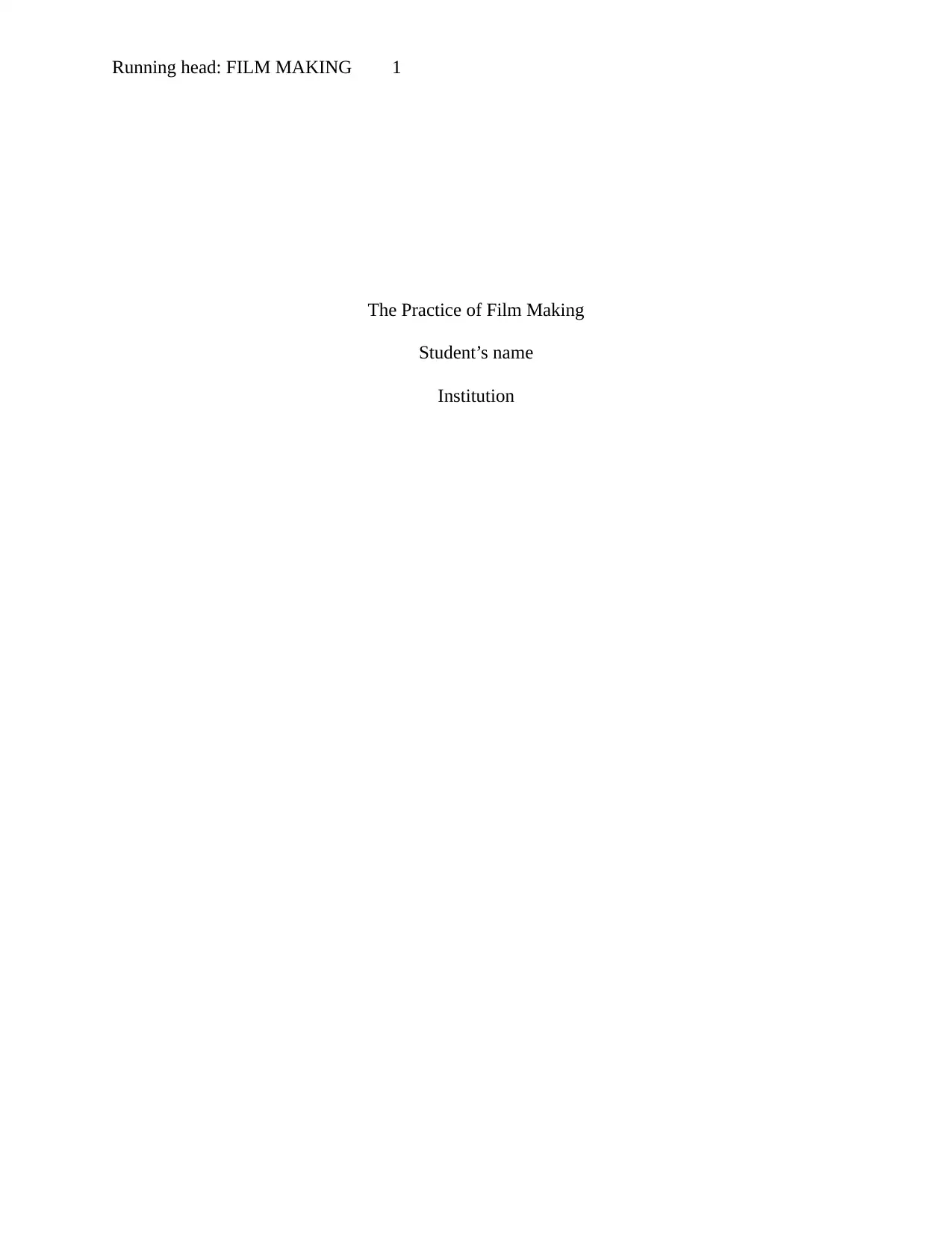
Running head: FILM MAKING 1
The Practice of Film Making
Student’s name
Institution
The Practice of Film Making
Student’s name
Institution
Paraphrase This Document
Need a fresh take? Get an instant paraphrase of this document with our AI Paraphraser
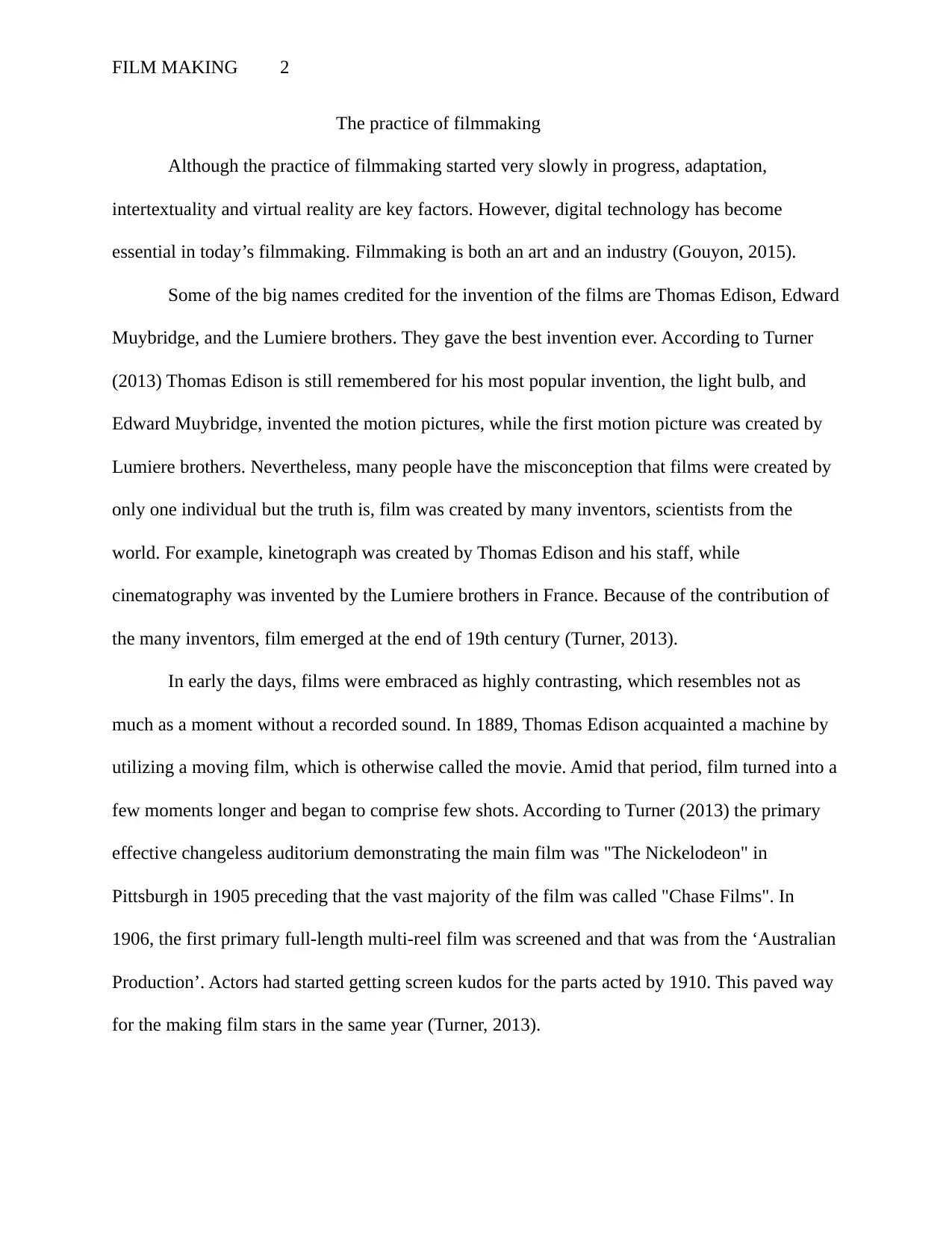
FILM MAKING 2
The practice of filmmaking
Although the practice of filmmaking started very slowly in progress, adaptation,
intertextuality and virtual reality are key factors. However, digital technology has become
essential in today’s filmmaking. Filmmaking is both an art and an industry (Gouyon, 2015).
Some of the big names credited for the invention of the films are Thomas Edison, Edward
Muybridge, and the Lumiere brothers. They gave the best invention ever. According to Turner
(2013) Thomas Edison is still remembered for his most popular invention, the light bulb, and
Edward Muybridge, invented the motion pictures, while the first motion picture was created by
Lumiere brothers. Nevertheless, many people have the misconception that films were created by
only one individual but the truth is, film was created by many inventors, scientists from the
world. For example, kinetograph was created by Thomas Edison and his staff, while
cinematography was invented by the Lumiere brothers in France. Because of the contribution of
the many inventors, film emerged at the end of 19th century (Turner, 2013).
In early the days, films were embraced as highly contrasting, which resembles not as
much as a moment without a recorded sound. In 1889, Thomas Edison acquainted a machine by
utilizing a moving film, which is otherwise called the movie. Amid that period, film turned into a
few moments longer and began to comprise few shots. According to Turner (2013) the primary
effective changeless auditorium demonstrating the main film was "The Nickelodeon" in
Pittsburgh in 1905 preceding that the vast majority of the film was called "Chase Films". In
1906, the first primary full-length multi-reel film was screened and that was from the ‘Australian
Production’. Actors had started getting screen kudos for the parts acted by 1910. This paved way
for the making film stars in the same year (Turner, 2013).
The practice of filmmaking
Although the practice of filmmaking started very slowly in progress, adaptation,
intertextuality and virtual reality are key factors. However, digital technology has become
essential in today’s filmmaking. Filmmaking is both an art and an industry (Gouyon, 2015).
Some of the big names credited for the invention of the films are Thomas Edison, Edward
Muybridge, and the Lumiere brothers. They gave the best invention ever. According to Turner
(2013) Thomas Edison is still remembered for his most popular invention, the light bulb, and
Edward Muybridge, invented the motion pictures, while the first motion picture was created by
Lumiere brothers. Nevertheless, many people have the misconception that films were created by
only one individual but the truth is, film was created by many inventors, scientists from the
world. For example, kinetograph was created by Thomas Edison and his staff, while
cinematography was invented by the Lumiere brothers in France. Because of the contribution of
the many inventors, film emerged at the end of 19th century (Turner, 2013).
In early the days, films were embraced as highly contrasting, which resembles not as
much as a moment without a recorded sound. In 1889, Thomas Edison acquainted a machine by
utilizing a moving film, which is otherwise called the movie. Amid that period, film turned into a
few moments longer and began to comprise few shots. According to Turner (2013) the primary
effective changeless auditorium demonstrating the main film was "The Nickelodeon" in
Pittsburgh in 1905 preceding that the vast majority of the film was called "Chase Films". In
1906, the first primary full-length multi-reel film was screened and that was from the ‘Australian
Production’. Actors had started getting screen kudos for the parts acted by 1910. This paved way
for the making film stars in the same year (Turner, 2013).
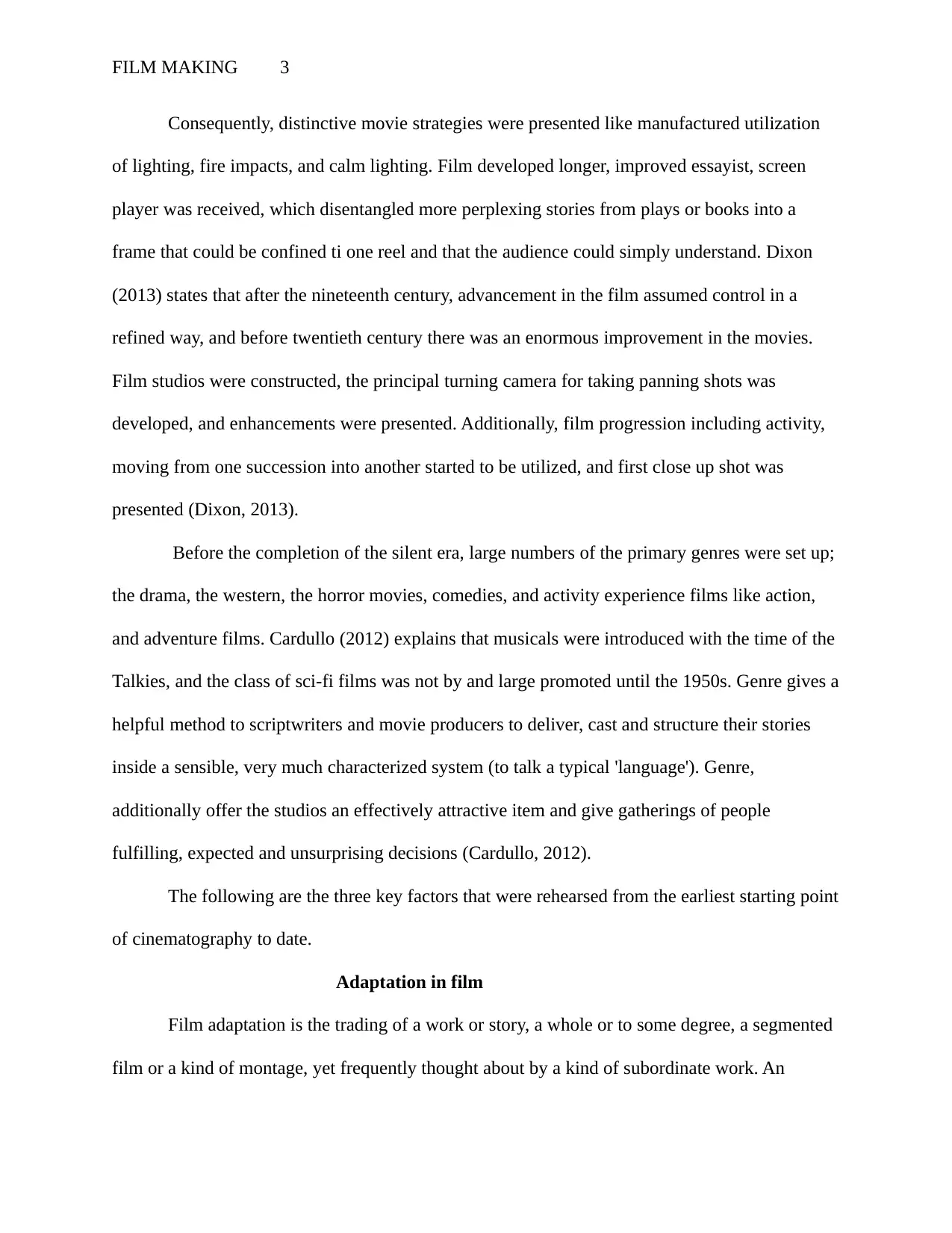
FILM MAKING 3
Consequently, distinctive movie strategies were presented like manufactured utilization
of lighting, fire impacts, and calm lighting. Film developed longer, improved essayist, screen
player was received, which disentangled more perplexing stories from plays or books into a
frame that could be confined ti one reel and that the audience could simply understand. Dixon
(2013) states that after the nineteenth century, advancement in the film assumed control in a
refined way, and before twentieth century there was an enormous improvement in the movies.
Film studios were constructed, the principal turning camera for taking panning shots was
developed, and enhancements were presented. Additionally, film progression including activity,
moving from one succession into another started to be utilized, and first close up shot was
presented (Dixon, 2013).
Before the completion of the silent era, large numbers of the primary genres were set up;
the drama, the western, the horror movies, comedies, and activity experience films like action,
and adventure films. Cardullo (2012) explains that musicals were introduced with the time of the
Talkies, and the class of sci-fi films was not by and large promoted until the 1950s. Genre gives a
helpful method to scriptwriters and movie producers to deliver, cast and structure their stories
inside a sensible, very much characterized system (to talk a typical 'language'). Genre,
additionally offer the studios an effectively attractive item and give gatherings of people
fulfilling, expected and unsurprising decisions (Cardullo, 2012).
The following are the three key factors that were rehearsed from the earliest starting point
of cinematography to date.
Adaptation in film
Film adaptation is the trading of a work or story, a whole or to some degree, a segmented
film or a kind of montage, yet frequently thought about by a kind of subordinate work. An
Consequently, distinctive movie strategies were presented like manufactured utilization
of lighting, fire impacts, and calm lighting. Film developed longer, improved essayist, screen
player was received, which disentangled more perplexing stories from plays or books into a
frame that could be confined ti one reel and that the audience could simply understand. Dixon
(2013) states that after the nineteenth century, advancement in the film assumed control in a
refined way, and before twentieth century there was an enormous improvement in the movies.
Film studios were constructed, the principal turning camera for taking panning shots was
developed, and enhancements were presented. Additionally, film progression including activity,
moving from one succession into another started to be utilized, and first close up shot was
presented (Dixon, 2013).
Before the completion of the silent era, large numbers of the primary genres were set up;
the drama, the western, the horror movies, comedies, and activity experience films like action,
and adventure films. Cardullo (2012) explains that musicals were introduced with the time of the
Talkies, and the class of sci-fi films was not by and large promoted until the 1950s. Genre gives a
helpful method to scriptwriters and movie producers to deliver, cast and structure their stories
inside a sensible, very much characterized system (to talk a typical 'language'). Genre,
additionally offer the studios an effectively attractive item and give gatherings of people
fulfilling, expected and unsurprising decisions (Cardullo, 2012).
The following are the three key factors that were rehearsed from the earliest starting point
of cinematography to date.
Adaptation in film
Film adaptation is the trading of a work or story, a whole or to some degree, a segmented
film or a kind of montage, yet frequently thought about by a kind of subordinate work. An
⊘ This is a preview!⊘
Do you want full access?
Subscribe today to unlock all pages.

Trusted by 1+ million students worldwide
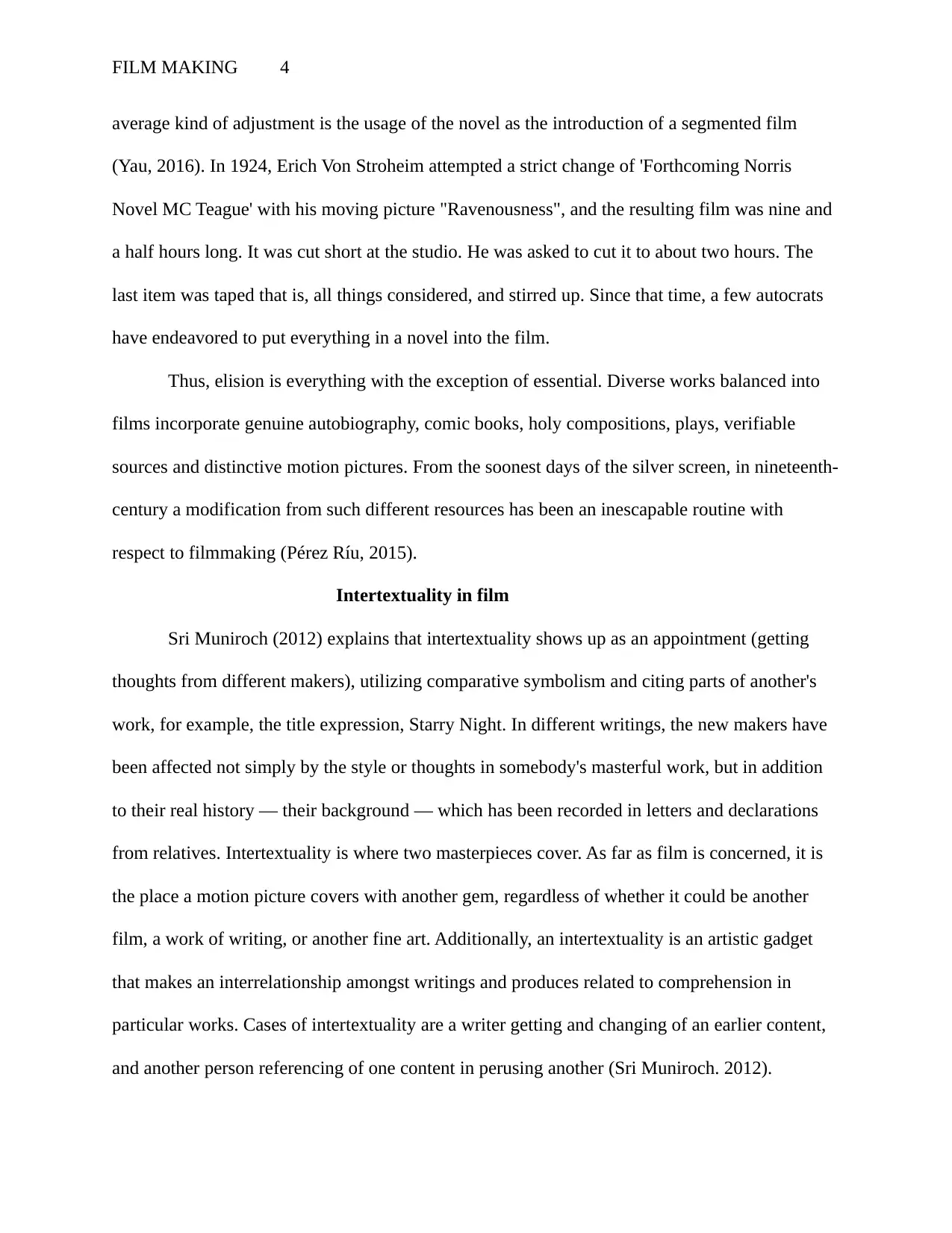
FILM MAKING 4
average kind of adjustment is the usage of the novel as the introduction of a segmented film
(Yau, 2016). In 1924, Erich Von Stroheim attempted a strict change of 'Forthcoming Norris
Novel MC Teague' with his moving picture "Ravenousness", and the resulting film was nine and
a half hours long. It was cut short at the studio. He was asked to cut it to about two hours. The
last item was taped that is, all things considered, and stirred up. Since that time, a few autocrats
have endeavored to put everything in a novel into the film.
Thus, elision is everything with the exception of essential. Diverse works balanced into
films incorporate genuine autobiography, comic books, holy compositions, plays, verifiable
sources and distinctive motion pictures. From the soonest days of the silver screen, in nineteenth-
century a modification from such different resources has been an inescapable routine with
respect to filmmaking (Pérez Ríu, 2015).
Intertextuality in film
Sri Muniroch (2012) explains that intertextuality shows up as an appointment (getting
thoughts from different makers), utilizing comparative symbolism and citing parts of another's
work, for example, the title expression, Starry Night. In different writings, the new makers have
been affected not simply by the style or thoughts in somebody's masterful work, but in addition
to their real history — their background — which has been recorded in letters and declarations
from relatives. Intertextuality is where two masterpieces cover. As far as film is concerned, it is
the place a motion picture covers with another gem, regardless of whether it could be another
film, a work of writing, or another fine art. Additionally, an intertextuality is an artistic gadget
that makes an interrelationship amongst writings and produces related to comprehension in
particular works. Cases of intertextuality are a writer getting and changing of an earlier content,
and another person referencing of one content in perusing another (Sri Muniroch. 2012).
average kind of adjustment is the usage of the novel as the introduction of a segmented film
(Yau, 2016). In 1924, Erich Von Stroheim attempted a strict change of 'Forthcoming Norris
Novel MC Teague' with his moving picture "Ravenousness", and the resulting film was nine and
a half hours long. It was cut short at the studio. He was asked to cut it to about two hours. The
last item was taped that is, all things considered, and stirred up. Since that time, a few autocrats
have endeavored to put everything in a novel into the film.
Thus, elision is everything with the exception of essential. Diverse works balanced into
films incorporate genuine autobiography, comic books, holy compositions, plays, verifiable
sources and distinctive motion pictures. From the soonest days of the silver screen, in nineteenth-
century a modification from such different resources has been an inescapable routine with
respect to filmmaking (Pérez Ríu, 2015).
Intertextuality in film
Sri Muniroch (2012) explains that intertextuality shows up as an appointment (getting
thoughts from different makers), utilizing comparative symbolism and citing parts of another's
work, for example, the title expression, Starry Night. In different writings, the new makers have
been affected not simply by the style or thoughts in somebody's masterful work, but in addition
to their real history — their background — which has been recorded in letters and declarations
from relatives. Intertextuality is where two masterpieces cover. As far as film is concerned, it is
the place a motion picture covers with another gem, regardless of whether it could be another
film, a work of writing, or another fine art. Additionally, an intertextuality is an artistic gadget
that makes an interrelationship amongst writings and produces related to comprehension in
particular works. Cases of intertextuality are a writer getting and changing of an earlier content,
and another person referencing of one content in perusing another (Sri Muniroch. 2012).
Paraphrase This Document
Need a fresh take? Get an instant paraphrase of this document with our AI Paraphraser
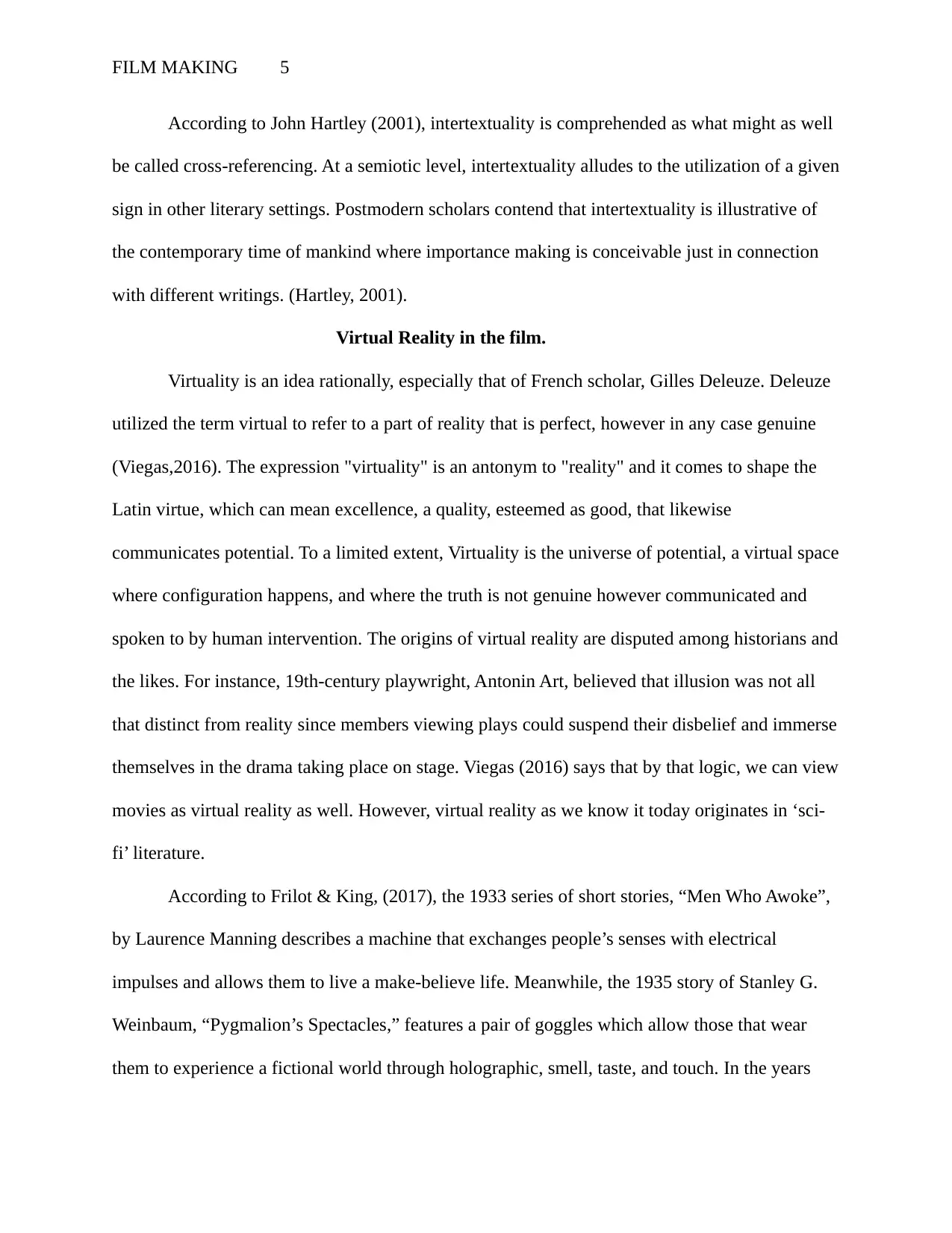
FILM MAKING 5
According to John Hartley (2001), intertextuality is comprehended as what might as well
be called cross-referencing. At a semiotic level, intertextuality alludes to the utilization of a given
sign in other literary settings. Postmodern scholars contend that intertextuality is illustrative of
the contemporary time of mankind where importance making is conceivable just in connection
with different writings. (Hartley, 2001).
Virtual Reality in the film.
Virtuality is an idea rationally, especially that of French scholar, Gilles Deleuze. Deleuze
utilized the term virtual to refer to a part of reality that is perfect, however in any case genuine
(Viegas,2016). The expression "virtuality" is an antonym to "reality" and it comes to shape the
Latin virtue, which can mean excellence, a quality, esteemed as good, that likewise
communicates potential. To a limited extent, Virtuality is the universe of potential, a virtual space
where configuration happens, and where the truth is not genuine however communicated and
spoken to by human intervention. The origins of virtual reality are disputed among historians and
the likes. For instance, 19th-century playwright, Antonin Art, believed that illusion was not all
that distinct from reality since members viewing plays could suspend their disbelief and immerse
themselves in the drama taking place on stage. Viegas (2016) says that by that logic, we can view
movies as virtual reality as well. However, virtual reality as we know it today originates in ‘sci-
fi’ literature.
According to Frilot & King, (2017), the 1933 series of short stories, “Men Who Awoke”,
by Laurence Manning describes a machine that exchanges people’s senses with electrical
impulses and allows them to live a make-believe life. Meanwhile, the 1935 story of Stanley G.
Weinbaum, “Pygmalion’s Spectacles,” features a pair of goggles which allow those that wear
them to experience a fictional world through holographic, smell, taste, and touch. In the years
According to John Hartley (2001), intertextuality is comprehended as what might as well
be called cross-referencing. At a semiotic level, intertextuality alludes to the utilization of a given
sign in other literary settings. Postmodern scholars contend that intertextuality is illustrative of
the contemporary time of mankind where importance making is conceivable just in connection
with different writings. (Hartley, 2001).
Virtual Reality in the film.
Virtuality is an idea rationally, especially that of French scholar, Gilles Deleuze. Deleuze
utilized the term virtual to refer to a part of reality that is perfect, however in any case genuine
(Viegas,2016). The expression "virtuality" is an antonym to "reality" and it comes to shape the
Latin virtue, which can mean excellence, a quality, esteemed as good, that likewise
communicates potential. To a limited extent, Virtuality is the universe of potential, a virtual space
where configuration happens, and where the truth is not genuine however communicated and
spoken to by human intervention. The origins of virtual reality are disputed among historians and
the likes. For instance, 19th-century playwright, Antonin Art, believed that illusion was not all
that distinct from reality since members viewing plays could suspend their disbelief and immerse
themselves in the drama taking place on stage. Viegas (2016) says that by that logic, we can view
movies as virtual reality as well. However, virtual reality as we know it today originates in ‘sci-
fi’ literature.
According to Frilot & King, (2017), the 1933 series of short stories, “Men Who Awoke”,
by Laurence Manning describes a machine that exchanges people’s senses with electrical
impulses and allows them to live a make-believe life. Meanwhile, the 1935 story of Stanley G.
Weinbaum, “Pygmalion’s Spectacles,” features a pair of goggles which allow those that wear
them to experience a fictional world through holographic, smell, taste, and touch. In the years
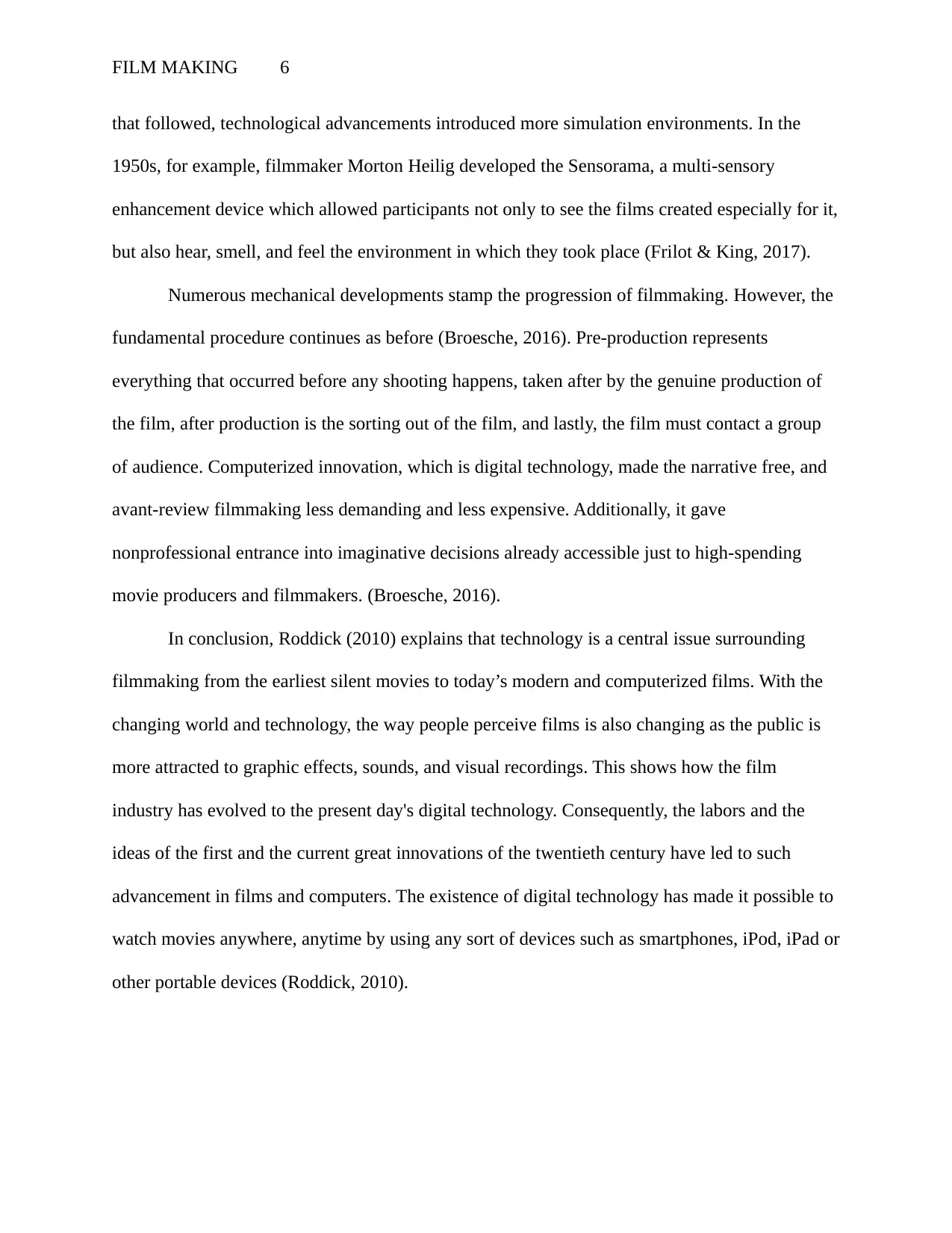
FILM MAKING 6
that followed, technological advancements introduced more simulation environments. In the
1950s, for example, filmmaker Morton Heilig developed the Sensorama, a multi-sensory
enhancement device which allowed participants not only to see the films created especially for it,
but also hear, smell, and feel the environment in which they took place (Frilot & King, 2017).
Numerous mechanical developments stamp the progression of filmmaking. However, the
fundamental procedure continues as before (Broesche, 2016). Pre-production represents
everything that occurred before any shooting happens, taken after by the genuine production of
the film, after production is the sorting out of the film, and lastly, the film must contact a group
of audience. Computerized innovation, which is digital technology, made the narrative free, and
avant-review filmmaking less demanding and less expensive. Additionally, it gave
nonprofessional entrance into imaginative decisions already accessible just to high-spending
movie producers and filmmakers. (Broesche, 2016).
In conclusion, Roddick (2010) explains that technology is a central issue surrounding
filmmaking from the earliest silent movies to today’s modern and computerized films. With the
changing world and technology, the way people perceive films is also changing as the public is
more attracted to graphic effects, sounds, and visual recordings. This shows how the film
industry has evolved to the present day's digital technology. Consequently, the labors and the
ideas of the first and the current great innovations of the twentieth century have led to such
advancement in films and computers. The existence of digital technology has made it possible to
watch movies anywhere, anytime by using any sort of devices such as smartphones, iPod, iPad or
other portable devices (Roddick, 2010).
that followed, technological advancements introduced more simulation environments. In the
1950s, for example, filmmaker Morton Heilig developed the Sensorama, a multi-sensory
enhancement device which allowed participants not only to see the films created especially for it,
but also hear, smell, and feel the environment in which they took place (Frilot & King, 2017).
Numerous mechanical developments stamp the progression of filmmaking. However, the
fundamental procedure continues as before (Broesche, 2016). Pre-production represents
everything that occurred before any shooting happens, taken after by the genuine production of
the film, after production is the sorting out of the film, and lastly, the film must contact a group
of audience. Computerized innovation, which is digital technology, made the narrative free, and
avant-review filmmaking less demanding and less expensive. Additionally, it gave
nonprofessional entrance into imaginative decisions already accessible just to high-spending
movie producers and filmmakers. (Broesche, 2016).
In conclusion, Roddick (2010) explains that technology is a central issue surrounding
filmmaking from the earliest silent movies to today’s modern and computerized films. With the
changing world and technology, the way people perceive films is also changing as the public is
more attracted to graphic effects, sounds, and visual recordings. This shows how the film
industry has evolved to the present day's digital technology. Consequently, the labors and the
ideas of the first and the current great innovations of the twentieth century have led to such
advancement in films and computers. The existence of digital technology has made it possible to
watch movies anywhere, anytime by using any sort of devices such as smartphones, iPod, iPad or
other portable devices (Roddick, 2010).
⊘ This is a preview!⊘
Do you want full access?
Subscribe today to unlock all pages.

Trusted by 1+ million students worldwide
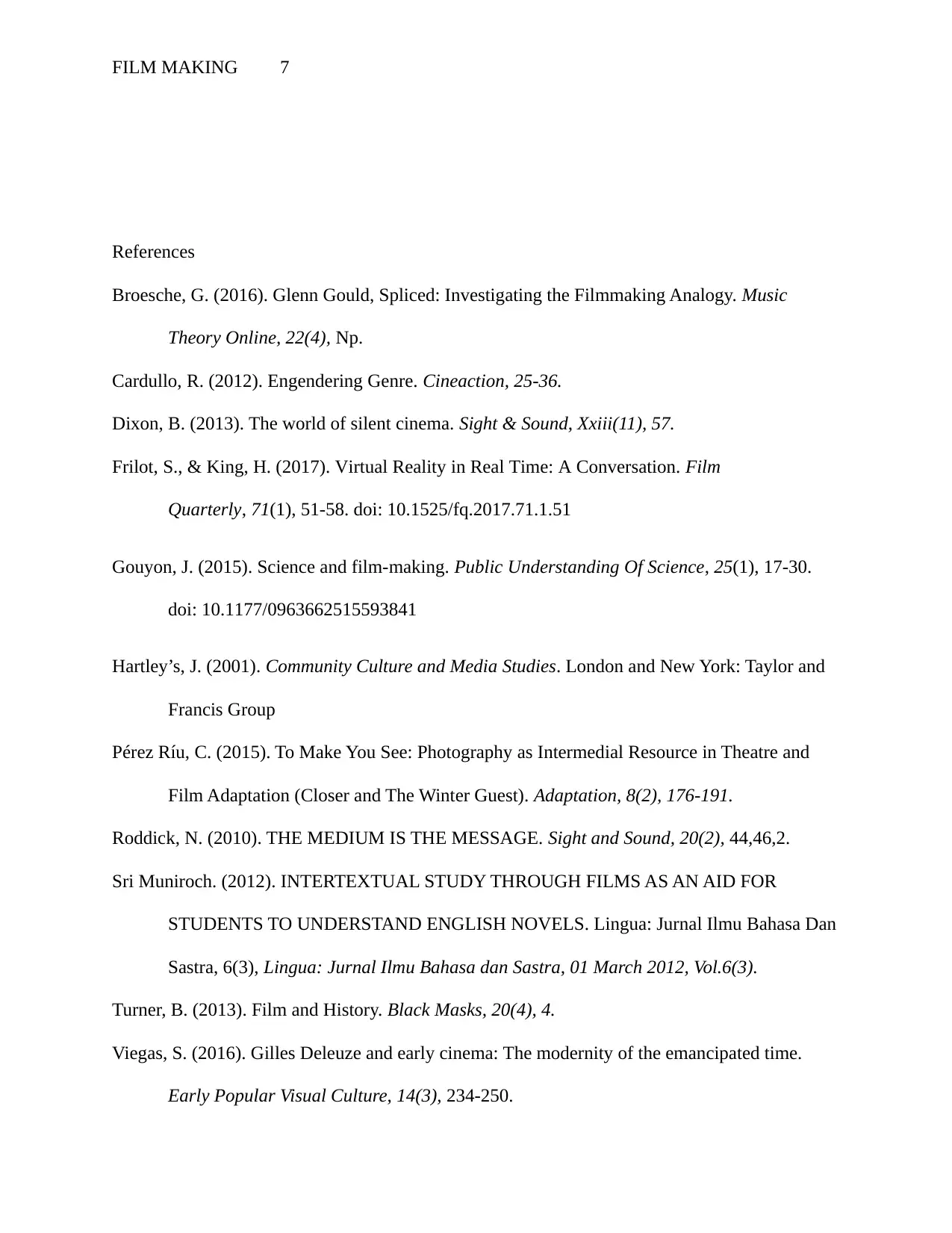
FILM MAKING 7
References
Broesche, G. (2016). Glenn Gould, Spliced: Investigating the Filmmaking Analogy. Music
Theory Online, 22(4), Np.
Cardullo, R. (2012). Engendering Genre. Cineaction, 25-36.
Dixon, B. (2013). The world of silent cinema. Sight & Sound, Xxiii(11), 57.
Frilot, S., & King, H. (2017). Virtual Reality in Real Time: A Conversation. Film
Quarterly, 71(1), 51-58. doi: 10.1525/fq.2017.71.1.51
Gouyon, J. (2015). Science and film-making. Public Understanding Of Science, 25(1), 17-30.
doi: 10.1177/0963662515593841
Hartley’s, J. (2001). Community Culture and Media Studies. London and New York: Taylor and
Francis Group
Pérez Ríu, C. (2015). To Make You See: Photography as Intermedial Resource in Theatre and
Film Adaptation (Closer and The Winter Guest). Adaptation, 8(2), 176-191.
Roddick, N. (2010). THE MEDIUM IS THE MESSAGE. Sight and Sound, 20(2), 44,46,2.
Sri Muniroch. (2012). INTERTEXTUAL STUDY THROUGH FILMS AS AN AID FOR
STUDENTS TO UNDERSTAND ENGLISH NOVELS. Lingua: Jurnal Ilmu Bahasa Dan
Sastra, 6(3), Lingua: Jurnal Ilmu Bahasa dan Sastra, 01 March 2012, Vol.6(3).
Turner, B. (2013). Film and History. Black Masks, 20(4), 4.
Viegas, S. (2016). Gilles Deleuze and early cinema: The modernity of the emancipated time.
Early Popular Visual Culture, 14(3), 234-250.
References
Broesche, G. (2016). Glenn Gould, Spliced: Investigating the Filmmaking Analogy. Music
Theory Online, 22(4), Np.
Cardullo, R. (2012). Engendering Genre. Cineaction, 25-36.
Dixon, B. (2013). The world of silent cinema. Sight & Sound, Xxiii(11), 57.
Frilot, S., & King, H. (2017). Virtual Reality in Real Time: A Conversation. Film
Quarterly, 71(1), 51-58. doi: 10.1525/fq.2017.71.1.51
Gouyon, J. (2015). Science and film-making. Public Understanding Of Science, 25(1), 17-30.
doi: 10.1177/0963662515593841
Hartley’s, J. (2001). Community Culture and Media Studies. London and New York: Taylor and
Francis Group
Pérez Ríu, C. (2015). To Make You See: Photography as Intermedial Resource in Theatre and
Film Adaptation (Closer and The Winter Guest). Adaptation, 8(2), 176-191.
Roddick, N. (2010). THE MEDIUM IS THE MESSAGE. Sight and Sound, 20(2), 44,46,2.
Sri Muniroch. (2012). INTERTEXTUAL STUDY THROUGH FILMS AS AN AID FOR
STUDENTS TO UNDERSTAND ENGLISH NOVELS. Lingua: Jurnal Ilmu Bahasa Dan
Sastra, 6(3), Lingua: Jurnal Ilmu Bahasa dan Sastra, 01 March 2012, Vol.6(3).
Turner, B. (2013). Film and History. Black Masks, 20(4), 4.
Viegas, S. (2016). Gilles Deleuze and early cinema: The modernity of the emancipated time.
Early Popular Visual Culture, 14(3), 234-250.
Paraphrase This Document
Need a fresh take? Get an instant paraphrase of this document with our AI Paraphraser
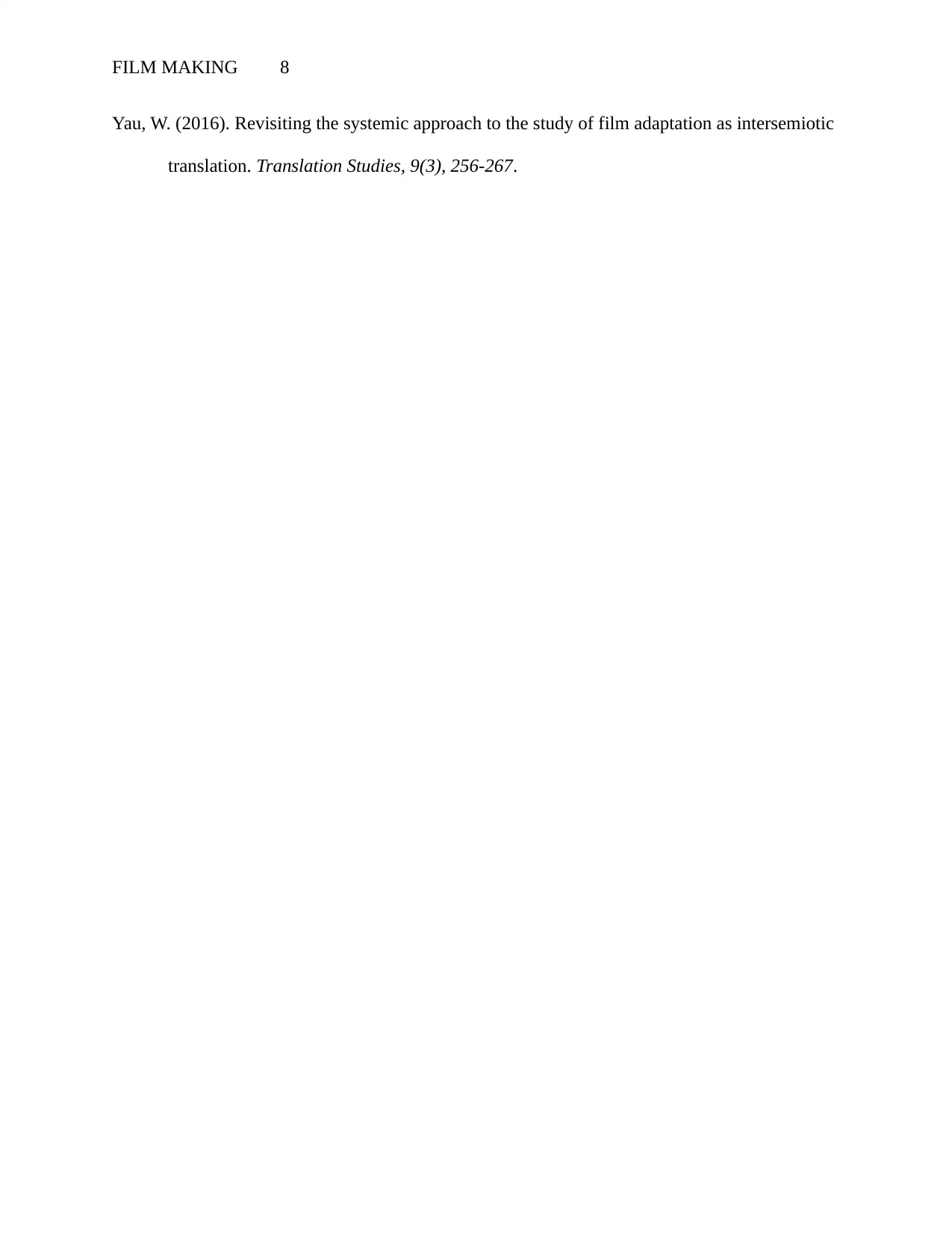
FILM MAKING 8
Yau, W. (2016). Revisiting the systemic approach to the study of film adaptation as intersemiotic
translation. Translation Studies, 9(3), 256-267.
Yau, W. (2016). Revisiting the systemic approach to the study of film adaptation as intersemiotic
translation. Translation Studies, 9(3), 256-267.
1 out of 8
Your All-in-One AI-Powered Toolkit for Academic Success.
+13062052269
info@desklib.com
Available 24*7 on WhatsApp / Email
![[object Object]](/_next/static/media/star-bottom.7253800d.svg)
Unlock your academic potential
Copyright © 2020–2025 A2Z Services. All Rights Reserved. Developed and managed by ZUCOL.